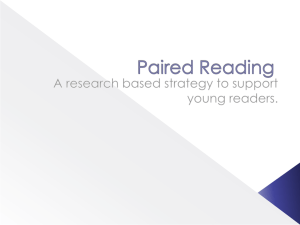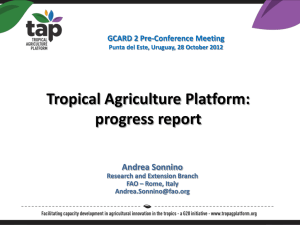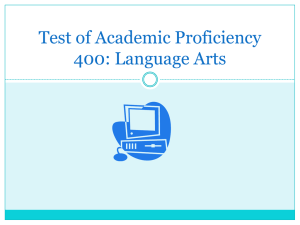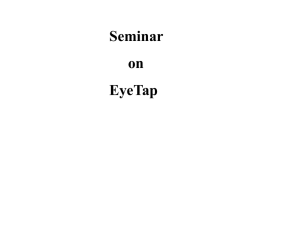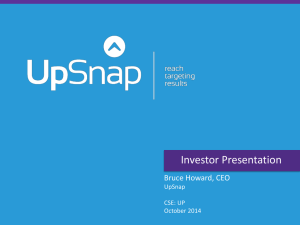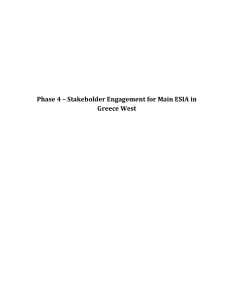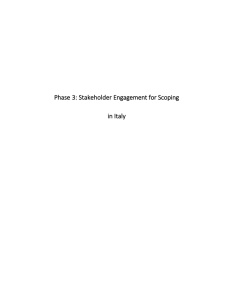in Italy
advertisement
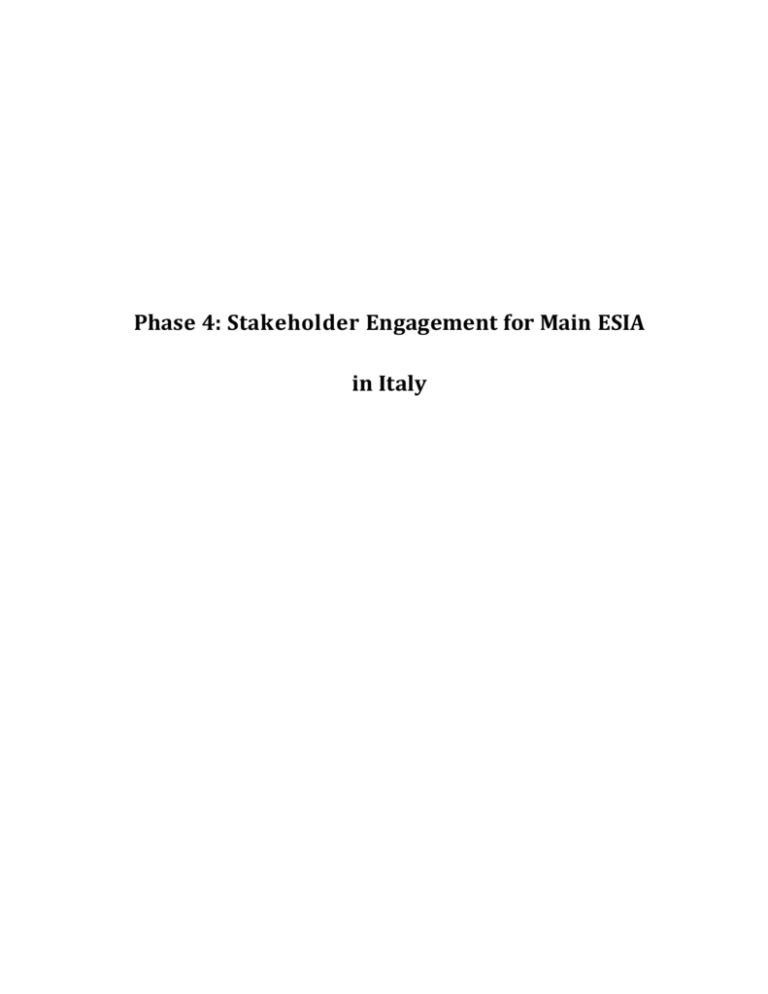
Phase 4: Stakeholder Engagement for Main ESIA in Italy 1 Methodology The main objective of this phase of stakeholder engagement was to complement the scoping engagement that was held in July-September 2011 in order to ensure that stakeholders had an opportunity to learn about the Project, to ask questions and raise concerns. The engagement was also used to gain information that was of importance in the assessment of impacts and development of mitigation measures The results of stakeholder engagement activities including how stakeholder comments have been taken into account are reported in the ESIA report. ESIA Disclosure activities highlighted the need for additional surveys, mainly geophysical and geotechnical studies. These would have to be performed along the whole route of the pipeline to confirm the geological characteristics of the area and the feasibility of the project. TAP decided to engage with landowners and ask each of them for their permission ahead of these surveys rather than enforcing the authorisation to perform the surveys through the existing institutional procedure (Art. 15 and 52 septies of DPR 327/01). This was done through a specific stakeholder engagement activity, which was referred to as Scouting Trip and is summarised in paragraph 4. 2 Stakeholders Engaged The following stakeholders have participated in the main ESIA phase meetings: Public Authorities • • • • Apulia Region; Ministry of Environment; Ministry of Economic Development; Municipalities Representative of Vernole and Melendugno NGOs • • • WWF and Legambiente, Lecce; Italia Nostra, Lecce. Save Salento, Lecce. Economic Associations • Confederazione Italiana Agricoltori (CIA) - (Agriculture Association). • Confcommercio Religious Representation • Roman Catholic Church Community • • Public Meeting with the Municipalities and Settlements totally or partially falling within a 2km corridor along the route of the pipeline, or interested in the Project outcome. Key Informant Interviews and Focus Groups with primary stakeholders: Fishermen, Women, Elderly, Labour Experts, Agriculture Representatives and Farmers, Tourism businesses. 3 Summary of Discussions with Stakeholders The main environmental and social issues raised during this phase of stakeholder engagement are summarised in the following Table 1 below. Table 1: Key Environmental and Social Issues Raised during the Main ESIA Meetings. Issue Title TAP Project Issue Description Main Stakeholder(s) Who Raised The Issue A diverse range of questions were raised to gain Municipality of Melendugno and Vernole further clarity on aspects of the Project particularly around the routing and location of the PRT and block valve station. PRT TAP should move the Pipeline Receiving Municipalities Terminal from the Municipality of Vernole to Meledugno. Health & safety: There was some concern with regard to health or Community safety implications of the gas pipeline and associated facilities. Concerns regarding business activities (Tourism) Stakeholders in the tourism business expressed Tourism Businesses concerns about the impact of the Project on their business activities. There was some concern with regard to the Project impact on the development of tourism activities in the area. The major concern was that the Project could indirectly stimulate investment in the industrial sector, while stakeholders would like to develop the tourism sector. Worries about sea pollution and rock erosion with Fishermen and Fishermen Representatives Concerns regarding natural subsequent visibility of the pipe and danger to ground stability. A few fishermen raised concerns resources about potential leaks which could cause long term damage to the marine environment. Communication regarding the project A local authority pointed out that there should be Community some informational material, maps and documents with information about the pipeline safety in emergency situations. Other stakeholders would like to know what the economic gains would be for the citizens and for the territory, in terms of jobs and investments. Other impacts and their management Questions were raised with regard to how a range of impacts would be managed. Examples include: noise and disturbance, potential contamination of water resources; interaction with local development areas and tourism and agriculture activities; cultural heritage. A concern regards the sea turtles that in certain periods of the year use the study area’s beaches to nest and lay their eggs (from June), thus construction activities should be avoided during the summer season. Stakeholders asked questions with regard to benefits that they might receive from the Project. Sometimes, these questions were articulated as community needs. Key areas of benefit raised were: road improvements; improvement to community infrastructure. The potential that the Project would improve access to gas was raised by a few stakeholders. Some of those consulted were also interested in the source of the gas. Sea Turtles Project benefits Purchase of gas Community Tourism operators, Legambiente, WWF Community, Municipalities Community 4 Scouting Trip The Scouting Trip included the following main activities: • Meeting with the Municipalities to request possible collaboration on the identification of landowners and their contact details. • Phone calls to landowners, whose telephone details were available, setting up individual meetings and requesting information on landowners from their neighbours. • Contacting the agriculture associations to ask for their collaboration in finding landowners information. • Meeting with landowners to request written approval for performing geophysical and geotechnical surveys. The messages given to landowners and the purpose of the meetings were the following: • Presenting the TAP Project and progress; • Explaining the ESIA Disclosure strategy and the plans to organise meetings locally; • Showing the cadastral map and identifying the landowner’s plots crossed by the pipeline; • Clearly describing the type of survey activities to be carried out; • Clarifying period and duration of the activities on the field; • Presenting the authorisation letter and requesting to sign it and receive a compensation for granting TAP an access to the land for the survey purposes. During the Scouting Trip activities that were held between November and December 2012, almost two thirds of the landowners (45 out of 62) were contacted, however, half of those who were contacted refused to meet TAP/ERM representatives. Out of 23 landowners that agreed to meet, 15 accepted to sign the agreement and received the financial compensation for. The main discussion areas of the meetings held during the main ESIA consultation phase are recorded in Table 2 below. Table 2: Stakeholder Engagement Meetings Records during Main ESIA Phase Stakeholders consulted Type of engagement activity Fishermen and Focus Group Fishermen and Key Representatives informant interview Tourism Businesses Key informant interview Farmers and Key informant Agriculture interview Representatives Specific discussion Areas Timing Stakeholders declared the following: • Most worries are caused by the fear of possible leaks, monitoring of the works and subsoil damages. • The pipeline could create trouble to the fishing, for instance there could be leaks. • Normally if the monitoring and maintenance is done continuously and specifically, the pipeline could work with no accidents, but, generally, the sea and its voracious force have to be taken into account. Stakeholders declared the following: • Damages on the Tourism business if the construction works will be performed during the summer months. The constructions should not be carried out during summer period. • Pipe visibility is very important (it should absolutely not be visible). • Fast rock erosion with subsequent visibility of the pipe and danger for the ground stability. • Existence of an underground stream which has an unstable path. • Environmental impact should be minor or insignificant. • Environmental associations have created false alarms, which have endangered the business activity. • Worries about sea pollution. • If the project brings along economic advantages, it is ok. • If it is guaranteed that the pipeline will not pollute the sea, it is ok, but the nature has to be protected and respected. • Concerns that the construction can bring along illegal activities, such as the dumping of toxic or radioactive waste. • Trust in the institutions. There are people informed and “super-partes” which will protect the environment and the interests of the population. • Concerns that the people outside “Salento” could think that the Salento has been damaged by the pipeline. • The coast rock is very exposed to the erosion. Fear that this factor will be underrated. • There are underground rivers, risks that this factor will be underrated. • The sea equilibrium is very weak and slight changes of the sea bed as a consequence of the works could cause change of sea currents and the collapse of the sea equilibrium. • People will have a negative psychological impact, thus overreacting to the pipeline project and not coming to the beach anymore. • A concern regards the sea turtles that in certain periods of the year use the study area’s beaches to nest and lay their eggs (from June), thus construction activities should be avoided during the summer season. October, 2011 (Field Works – FW) • October, 2011 (FW) The major concerns are related to the land restoration and the change of land use during operation. October, 2011 (FW) Stakeholders consulted Women Type of engagement activity Focus Group and Key informant interview Elderly Key informant interview Ministry of Environment Face to Face Municipalities of Face to Face Vernole and Melendugno Specific discussion Areas Timing Stakeholders declared the following: • Effects on the sea. Previous projects have caused damages to the environment (The water purifier broke and drowned some areas with sewage water.). • There will be visible consequences. • They would like to know if there are any risks for the health. • They fear the pipeline can damage the environment. • They know the peculiarities of the pipeline construction, including the monitoring phase. She thinks the environmental impact will be none. Stakeholders declared the following: • In the second hypotheses he is worried for the ruin of 4-5 hectares of land for the change of the utilization. • In general he is worried and he does not trust the administrative capabilities of the Municipality. • He has some concerns regard the environmental impact. • He has some perplexity regarding the safety of the pipeline, he fears it can suddenly explode. • Normally if the monitoring and maintenance is done continuously and specifically, the pipeline could work with no accidents, but, generally, the sea and its voracious force have to be taken into account. He has perplexities concerning the risk of leaks as he supposes that the gas in the pipeline will be put under pressure. He is worried about the easiness with which some political decisions may be taken, following a logic which does not include environmental sensibility and that the permits will be given without prior consultation of the affected communities, thus being forced to accept the decisions with no possibility of reply. • Discussions were predominately focused around Project authorisation and approval to proceed with the ESIA submission. October, 2011 (FW) • November 22, 2011 • • • Municipality of Vernole Face to Face • • • The mayors are in full alignment that the project needs to be presented to the population along with the benefits of the Convenzione and commit to how the funds will be used: school, park, road improvements, etc. The Gas consumption in the Area is pretty low. There is an interest in having more information about the gas cost, and if this cost will decrease at local level due to the Project. The mayors will be developing a list of community needs and we will work with them to develop a specific Convenzione that fits the needs and links the funds. This will be part of the preparation for the town hall meeting in January. The Vice mayor of Vernole raised a concern about the terminal location. TAP and the municipality will have an additional meeting to discuss and explain the studies conducted and benefits vs the negatives. October, 2011 (FW) November 18, 2011 November 23, Vernole mayor provided a summary of the ongoing discussions between TAP and the municipality and the objectives of the 2011 meeting: 1) Finalize PRT location; 2) Start discussion on the Convenzione The issues identified during the meetings were: a) Terminal too close to Aquarica. Distance is about 1 km. b) Proposed route of the line leaving the terminal, to be built by Snam, will place a limit on the development of Aquarica. The new road development for SR8 will also place limitations on the development of Aquarica. c) Vice-Mayor wants to place the PRT near the quarry, which is near the SR8. SR8 will have a right of way of 40 m on each side of the road and could also be used by the pipeline. The change in location of the PRT and extension of the TAP line to the zone of the quarry would be a significant change of scope and a major rework to the ESIA that is in development. d) TAP organized a field trip to the site with Saipem for the following week. The site visit will be done with Saipem, TAP and the Vernole & Melendugno urban planning engineers. e) Saipem has developed a plot plan for the terminal in the current location to show the minimal impact on the territory. f) TAP will contact Snam Rete gas to discuss this issue about their future scope h) TAP will be meeting with the Province of Lecce to understand how to use the right of way of the SR8 road. i) Other alternatives are to build the PRT within the Meledugno municipality. Stakeholders consulted Municipality of Vernole Regione Puglia – Ecological Department Type of engagement activity Face to Face Specific discussion Areas • • • • December 1, The Environmental Assessor asked about potential impacts on noise, air and odours of the PRT. 2011 TAP terminal location is near the area of the golf course and the land here is of high value. The pipeline leaving the terminal has to follow the regional road 8. The northern route is not acceptable. Vernole would support the terminal location at their industrial area and would clear i t as this area has been designated as an area of industrial development. Face to Face • As a representative of Regione Puglia has been not yet nominated by MoE in the EIA Commission, he will present his comments December 14, 2011 when the EIA will be submitted and the Conferenza dei Servizi takes place. He clarified that there are no protected sandy zones close to the project area and that the result of the CONISMA project will be publicly available during the Mediter Conference at the end of January. • Timing Ministry of Face to Face Economic Development – Communication Department December 14, • The MSE advised that in the project area there might be military communication lines not registered: an appropriate georadar 2011 survey must be done before excavation. • The MSE gave TAP the contacts at Telecom Italia where we can ask information about all the registered lines. Telecom might ask us that a technician of the Company will join the georadar survey for updating the maps of the communication lines. WWF and Legambiente • Face to Face • • • Gas is better than solar panels for the energy production, as it is desirable to avoid the use of agricultural land for solar panels December 16, 2011 installation due to their landscape impact. The concern is about the landfall point and the fragility of the rock coast. They would be interested in knowing the result of the studies carried out on the coast, to understand the level of tolerance of the rock to the micro-tunneling works. They underline the needs of infrastructure in the area, thus if TAP is considering investment in the area, infrastructure should be privileged. A concern regards the sea turtles that in certain periods of the year use the study area’s beaches to nest and lay their eggs (from June), thus construction activities should be avoided during the summer season. Roman Catholic Face to Face Church – Lecce • • • December 13, The Archbishop had not been informed about the Project. 2011 TAP disclosed information about the Project. Archbishop appreciates the effort of TAP in informing the community about the Project. However, if adverse impacts are likely to occur as a result of the Project, he would like to be sure that TAP will avoid / mitigate and monitor the impacts. Confederazione Face to Face Italiana Agricoltori (CIA) • • CIA Representative appreciates the effort of TAP in informing the community about the Project. CIA would like to know if TAP will invest in the area and how these investments will affect future generations. Additionally, he informed TAP that in the area: a. Agricultural enterprises are few, thus information about the Project should be disclosed to small farmer owners. b. People do not hold a positive view of Projects that are using agricultural land to place solar panels. December 13, 2011 Italian Nostra Face to Face • Italia Nostra would like: a. to have more information about the “entire” pipeline corridor including the section managed by SNAM. b. to know if a study on the coastline fragility was undertaken. A fragility assessment should be performed to ensure stakeholders that the Project will not negatively affect the soft rock coast in the vicinity of the landfall point. c. to know if positive impacts are likely to occur, how the Project will benefit Apulia region and Italy and how the Project fits into the Italian Energy Plan. d. to be sure that agricultural activity will be allowed on the safety zone. e. to be informed about the type of investments that will be implemented in the area interested by the Project. f. to know if/ how stakeholders affected by the Project will be compensated. December 13, 2011 Apulia Region Face to Face • • • • This meeting was organized by TAP to introduce the project and the scoping process to this regional authority. TAP presented the project and the status of the project TAP provided a copy of the scoping document TAP discussed the stakeholder engagement undertaken as part of the consultation period prior to the ESIA submittal The Region advised to meet Ing. Giordano of the Servizio Forestale & Ing. De Feudis of Servizio Demanio & Patrimonio. Both have been contacted. November 25, 2011 • Save Salento • Save Salento Representative would like to be informed about the following: a) how the Project will affect Acquarica development plan. b) the impact of the PRT during operation (emissions and safety). c) the visual impacts (PRT, BVS, and landfall). d) Any investment should be monitored by TAP to ensure that the community will be positively affected by the initiative. e) to have more information about the “entire” pipeline corridor (not only the 4.9 Km managed by TAP). f) They appreciate the effort made by TAP in informing the community and disclosing information about the Project. Face to Face Confcommercio Face to Face • • December 15, 2011 December 16, TAP described the effort to inform and engage stakeholders Confcommercio representative approved the communication approach used with stakeholders and hope that TAP project will 2011 elicit a local economic growth. Stakeholders consulted Type of Specific discussion Areas Timing engagement activity Public Meeting Public Meeting • There was some concern with regard to health or safety implications of the gas pipeline and associated facilities. February 16, with the • Concerns regarding business activities: Stakeholders in the tourism business expressed concerns about the impact of the 2012 Municipalities Project on their business activities. The major concern was that the Project could indirectly stimulate investment in the industrial and Settlements sector, while stakeholders would like to develop the tourism sector. within a • Worries about sea pollution and rock erosion with subsequent visibility of the pipe and danger to ground stability. 2 km corridor • Other stakeholders would like to know what the economic gains would be for the citizens and for the territory, in terms of jobs along the and investments. pipeline route • Questions were raised with regard to how a range of impacts would be managed. Examples include: noise and disturbance, and everyone potential contamination of water resources; interaction with local development areas and tourism and agriculture activities; interested in the cultural heritage. Project • Stakeholders were concerned about the fact that the Municipality does not disclosed information earlier. • They would like to have more information about the “entire” pipeline corridor (not only the 4.9 Km managed by TAP).



